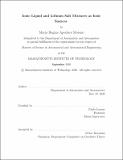Ionic liquid and lithium salt mixtures as ionic sources
Author(s)
Apodaca Moreno, Maria Regina.
Download1227278419-MIT.pdf (6.039Mb)
Other Contributors
Massachusetts Institute of Technology. Department of Aeronautics and Astronautics.
Advisor
Paulo Lozano.
Terms of use
Metadata
Show full item recordAbstract
Ionic liquids (ILs) are molten salts that are used in electrospray thrusters as the source for the ionic emission. The total current of the emitted ions is proportional to the conductivity and the surface tension of the ionic liquid. Since the thrust of the propulsion system is dependent on the current, we try to maximize the total current emitted. However, the production of new ionic liquids is very challenging and thus this thesis explores the use of mixtures as an alternative ionic source. This thesis studies the relationship that exists between temperature, conductivity and surface tension with the concentration of LiBF₄ salt in the EMIBF₄ ionic liquid. The solvent was selected given it is one of the most commonly used ionic liquids in electrospray propulsion. The salt, on the other hand, was selected because of its small and simple positive ion Li⁺ and its matching negative ion, BF⁻₄ to that of the IL. From measurements at a concentration of 27wt% time of flight spectrometer, an increase in the percentage of the beam that was single EMI⁺ from ~ 50% to ~ 70%. This lead to an increase in efficiency of ~ 2% and specific impulse of ~ 27%. It was found that the surface tension of the mixture decreases as the concentration increases. Likewise, the conductivity tends to decrease as the weight percentage of salt is increased, except for a local maximum around 15wt%.
Description
Thesis: S.M., Massachusetts Institute of Technology, Department of Aeronautics and Astronautics, September, 2020 Cataloged from student-submitted PDF of thesis. Includes bibliographical references (pages 75-76).
Date issued
2020Department
Massachusetts Institute of Technology. Department of Aeronautics and AstronauticsPublisher
Massachusetts Institute of Technology
Keywords
Aeronautics and Astronautics.